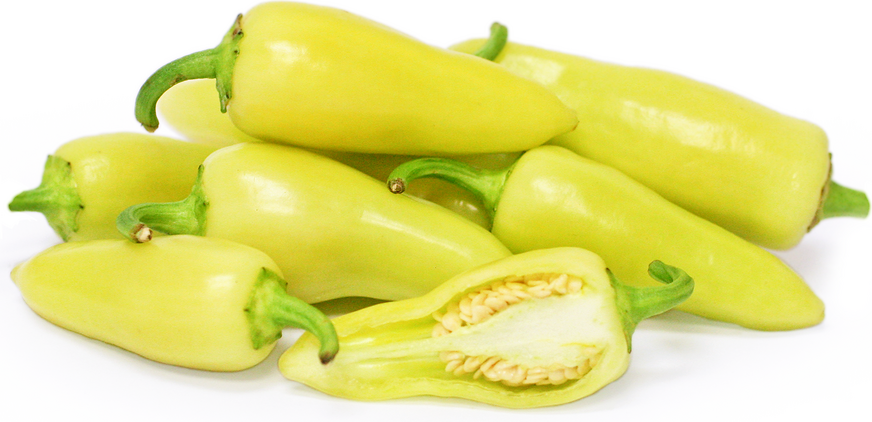


White Jalapeño Peppers
Estimated Inventory, lb : 0
Description/Taste
White Jalapeño chile peppers are curved to straight, broad pods, averaging 7 to 10 centimeters in length, and have a conical shape tapering to a rounded point on the non-stem end. The skin is smooth, ivory to pale yellow, taut, glossy, and is connected to a light green, fibrous stem. Underneath the surface, the thick flesh is crisp, pale yellow, and aqueous, encasing a central cavity filled with many round and flat, cream-colored seeds. White Jalapeño chile peppers have a vegetal, slightly fruity flavor mixed with a mild to moderate level of spice.
Seasons/Availability
White Jalapeño chile peppers are available in the summer.
Current Facts
White Jalapeño chile peppers, botanically classified as Capsicum annuum, are a rare variety that is a member of the Solanaceae or nightshade family. White Jalapeño chile peppers are often the result of a natural cross or spontaneous mutation that occurs when a pepper plant is missing a gene, causing the pod to be pale in color. There has also been some debate as White Jalapeño chile peppers are considered to be yellow jalapeño chile peppers by some experts. White Jalapeño chile peppers range 2,500-10,000 SHU on the Scoville scale and have a moderate level of heat. These peppers are not commercially produced and will only be found on occasion through small farms and home gardeners.
Nutritional Value
White Jalapeño chile peppers are an excellent source of vitamin C, which is an antioxidant that can help build collagen and boost immunity within the body. The peppers also contain some vitamin A, iron, phosphorus, and calcium.
Applications
White Jalapeño chile peppers are best suited for both raw and cooked applications such as stir-frying, roasting, baking, and grilling. The pale pods can be used interchangeably in recipes calling for green jalapeños and provide unusual coloring to dishes. Jalapeños are known for their thick walls and are classically stuffed pepper with cheeses, ground meats, and grains. Once stuffed, the pods are then roasted or fried and served as an appetizer or snack. White Jalapeño chile peppers can also be diced into salsas, sauces, marinades, and relishes, kneaded into doughs for bread, cornbread, and pasta, baked into casseroles, souffle, and dips, or sautéed with eggs to add a spicy kick. In addition to cooked applications, the peppers are popularly used for pickling and are used as a condiment over hot dogs, burgers, and sandwiches. White Jalapeño chile peppers pair well with meats such as fish, poultry, beef, and pork, fruits such as pineapple, mango, and kiwi, corn, cilantro, and avocado. Fresh peppers will keep up to one week when stored whole and unwashed in a paper bag in the refrigerator.
Ethnic/Cultural Info
In the United States, Tex-Mex cuisine frequently uses jalapeños to add subtle smoky flavors and moderate heat to dishes. The fusion cuisine was developed in the region that is modern-day Texas, and the land was influenced by Native American, Spanish, and Mexican cultures. Tex-Mex was initially created in home kitchens and was introduced in the 1880s in San Antonio when a group of women known as the “chili queens” sold chili con carne in city plazas. The dish rapidly increased in popularity, and throughout the late 1800s and early 1900s, new dishes were created such as the combo plate, nachos, and burritos, and were marketed under the Tex-Mex name, creating a popular style of cooking that is still used in the southwestern United States in the modern-day.
Geography/History
Jalapeños are native to Xalapa, which is the capital city of Veracruz, Mexico, and have been cultivated since ancient times. Spanish and Portuguese explorers introduced the pepper to Europe and Asia in the 15th and 16th centuries, and since then, the peppers have become cultivated worldwide. Since their worldwide introduction, the history of White Jalapeños is somewhat unknown, but some experts believe it may have been the product of a natural cross, mutation, or through selective breeding. Today White Jalapeño chile peppers are very rare and are available in limited quantities through specialty farms and home gardeners in Mexico and the United States.
Recipe Ideas
Recipes that include White Jalapeño Peppers. One
| Cuesa |
|
Pickled Vegetables |
| The Modern Proper |
|
Rhubarb Mint Margarita with Jalapeno Tequila |




